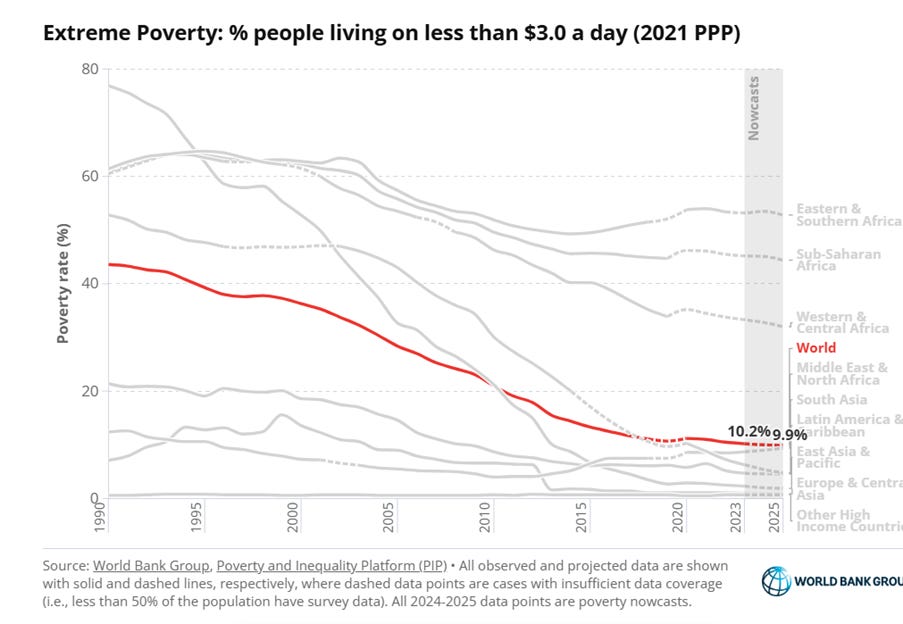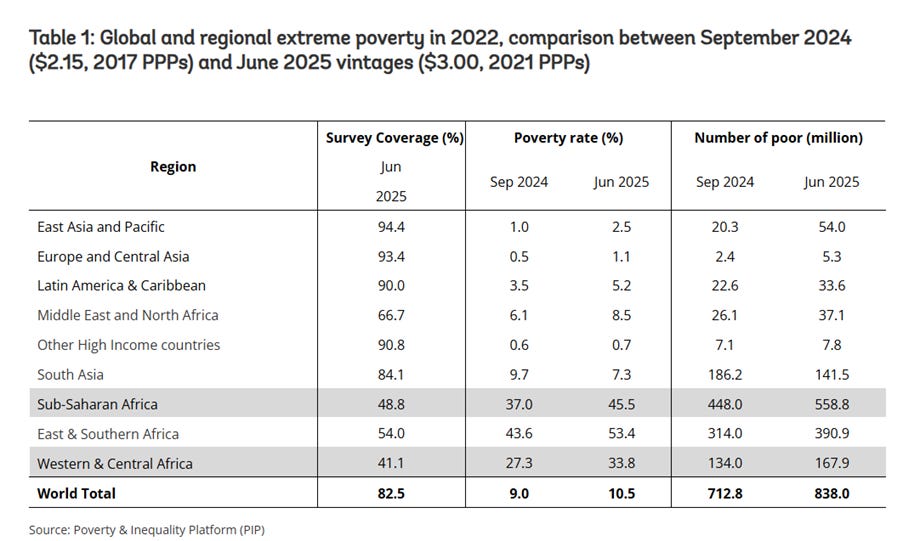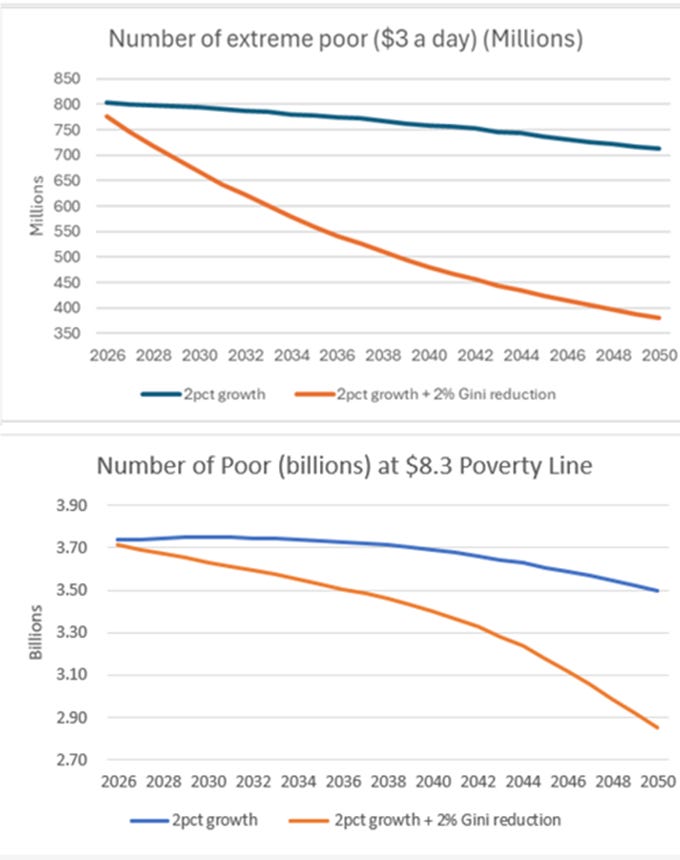Want to end poverty? Then reduce inequality.
New World Bank Numbers show 125 million more people living in extreme poverty than previously thought.
The World Bank have published revised poverty numbers, and the findings are pretty dramatic. They now think that there are 125 million more people living in extreme poverty in 2022 than they did previously- that extreme poverty is 10.5% of the world’s population, as opposed to their previous estimate of 9%. That is the equivalent to the entire population of Japan.
To quote their blog: ‘The update includes three main changes to the PIP data (See the What’s New document for more details): First, the update brings new survey data for several country-years, including important updates to data from India; second, it includes the adoption of the 2021 Purchasing Power Parities (PPPs); and third, based on the new PPPs and new survey data, including new national poverty lines, the update revises the global poverty lines.’
We already knew that poverty had shot up during Covid-19, and then begun to come down again, but very slowly. These new estimates show that the decline is even slower than originally projected, with extreme poverty in 2022 basically at the same level as it was in 2019. This then impacts on the World Bank forecasts for where poverty levels are in 2025- revised upwards from 8.5% of humanity to 9.9% of humanity- or one in ten people.
These are of course figures for extreme poverty. Oxfam along with many others have been very critical that this threshold that is too low. We pointed to the fact that the UN estimates that more people are living in hunger than the World Bank estimates are in extreme poverty. Now at least with these revised estimates this is no longer the case, with around 750 million living in hunger and 838 million in extreme poverty.
Nevertheless, the extreme poverty line remains far too low, and not a realistic assessment of what it is to be poor. In response to these criticisms the World Bank introduced and started using higher poverty lines, with the highest being $6.85 (now revised to $8.30- see para below) a day; at this rate the percentage of humanity living in poverty in 2022 given these revised estimates is now 48% and in 2025 projected to be 45.5%. This move by the World Bank was very welcome and gives a more realistic picture of poverty, both in overall numbers and in where it is located. With extreme poverty, the story was becoming more and more only about Africa, and this meant the global discussion of poverty and its impacts had begun to disappear from the rest of the world, which was not helpful. With this higher rate, the discussion is not just more realistic in terms of what it means to be poor, but also more realistic in showing that there continue to be large numbers of people living in poverty all over the world.
(As part of this revision the World Bank have also carried out one of their periodic revisions of the dollar equivalence for specific poverty lines in response to revisions in estimates of Purchasing Power Parity- what you are able to buy in your country for a set amount of dollars- so extreme poverty has gone from being $2.15 a day to $3 a day, and the higher poverty line from $6.85 to $8.30)

Prospects for further reductions in poverty very bleak indeed
What will happen over the next few years to poverty levels? This depends basically on two variables, economic growth and the level of inequality. Basically, if you grow your national economic pie, even if you do nothing to reduce inequality, poverty will still reduce; this is the classic trickle-down approach. Equally if you redistribute some of the economic pie and make your country more equal, then you will have a greater reduction in poverty.
The outlook for economic growth in the coming years is not rosy. Trade wars, actual wars, climate breakdown; all of these, even for the most upbeat forecaster, would suggest that banking on trickle down to end poverty is not a wise strategy. Add to this the total collapse in aid levels from the Global North to the Global South- with new numbers released by Oxfam this week as the G7 meeting Canada showing the biggest cut to G7 aid in the history of the G7, and the outlook is grim to say the least.
In their Poverty, Prosperity and Planet report, published before the swinging cuts to aid, The World Bank were already very pessimistic, and they are usually relentlessly upbeat. They estimated that with 2% growth shared equally within each country, it would take 60 years to bring extreme poverty down to the Sustainable Development Goal target of 3% globally, and that at the higher poverty rate of $8.30, it would take well over a century before poverty is eliminated.
Reducing inequality would triple the speed of poverty reduction
In the same report they also modelled what the impact would be if countries also managed to reduce inequality; in their model they look at a 2% reduction in inequality every year in addition to 2% growth. The team at the Bank have now kindly shared these updated figures to reflect the new poverty estimates. In this scenario, extreme poverty could be brought down close to the target in 20 years and not 60, or almost three times faster. At the higher poverty line, a reduction in inequality of 2% annually combined with 2% growth means there would be 646 million less people living in poverty in 2050 than if inequality remains unchanged- similar to the entire population of Latin America and Caribbean (658 million).
This also has the added and important benefit of being able to reduce poverty dramatically at much lower rates of growth than would otherwise be needed, which is good for the planet as more growth means more carbon.
A glimmer of hope to warm your hearts- a new Global Alliance Against Inequality is formed
It is hard to think of a better argument for nations focusing more on reducing inequality. Given this, it was very positive and exciting last week to see the launch by the German and Sierra Leonean governments of the new ‘Global Alliance against Inequality’ at the Hamburg Sustainability Conference. The joint statement, also signed by Norway and the Czechia, is powerful:
‘Extreme inequalities and power imbalances with a concentration of wealth and influence in the hands of a few at the expense of the majority hinder essential policy reforms. We will collectively seek to ensure that the reduction of inequality is strengthened as a global priority on the international agenda and that an overarching framework for action requiring sustained political will is further developed.’
We really hope this Alliance grows rapidly over the coming months, to pull together a strong group of countries from north and south that are serious about reducing inequality, with all its manifold benefits for both people and planet. To present a progressive economic coalition of the willing, standing in contrast to the Trumpian dystopia that can seem overwhelming. We will be doing all we can as Oxfam to support them in this.
ENDS.
For those with more interest in the World Bank revisions of the poverty numbers, The What’s new and associated blog; Paper (and replication package) and associated blog on the 2021 PPPs – this only came out earlier this week; A blog on why they are not simply moving goalposts; A blog on the link between national poverty lines and aggregates; Technical on adjusting for comparability breaks, and associated blog- a huge amount of work!
Author: Max Lawson, Head of Inequality Policy at Oxfam International and EQUALS podcast co-host. He is also the co-chair of the Global People’s Medicines Alliance.
Listen to our latest episode featuring Nick Shaxson on how monopoly power is shaping inequality.
Always remember to share and follow us on X and on LinkedIn.








